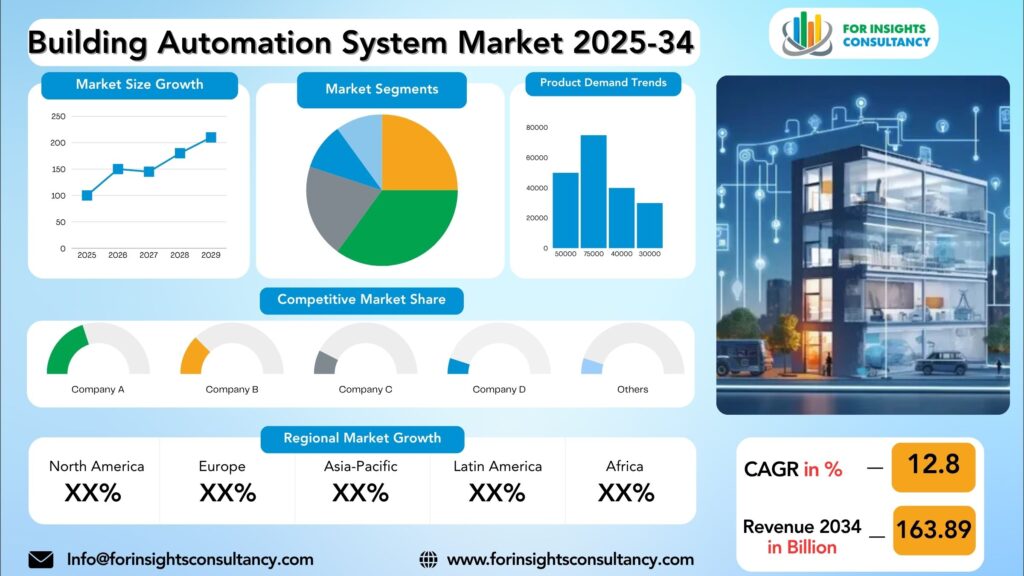
Building Automation System Market Size, Trends Analysis Research Report by Component (Hardware, Software, Services, Facility Management Systems,Security and Access Control Systems, Fire Protection Systems, Building Energy Management Systems (BEMS)), by System Type (HVAC Control Systems, Lighting Control Systems, Fire and Life-Safety Systems, Facility Management Systems, Building Energy Management Software, Safety and Security Systems)), by Communication Technology, and By End-User Industry, and By Region Global Market Analysis And Forecast, 2025-2034
Oct-2025 Formats | PDF | Category: Semiconductor | Delivery: 24 to 72 Hours
Building Automation System Market Is Forecast to Increase from USD 98.34 Billion In 2025 To USD 163.89 Billion By 2034, At A CAGR Of 12.8%.
Building automation system Market: A Comprehensive Overview and Future Developments
A major market that is impacting positively the growth of building automation system is energy efficiency solution demand in buildings. The systems are designed to incorporate various services such as HVAC, lighting, security, and energy management in a building, thereby enabling energy conservation and saving of operating costs. In addition, they provide benefits such as occupant comfort, remote access, and predictive maintenance. The trend of the market is therefore accompanied by innovations in technologies, and major companies such as Siemens, Honeywell, Johnson, and Schneider Electric are the foremost players. Strict orders for energy efficiency in buildings have made the North American market the players’ main area of influence. Rapid urbanization and smart building projects are drawing a lot of attention to the Asia-Pacific region, making it a key area for future growth in this market.
The development of IoT technology, cloud computing, and artificial intelligence has made the future of the building automation system market look bright. The evolution of technology will provide a more user-friendly connection between different systems in the building, better data analytics for decision-making, and more automation for building operations. The market will, therefore, be transformed from separate systems to gradual integration, hence the emergence of smart buildings that have interconnected systems which communicate to achieve energy-saving and user experience goals. As the priority of green energy and saving energy has turned into the owners and operators’ top concern, the need for updated automation systems is forecasted to increase by leaps and bounds in the future years.
Market Insights
- In 2024, the Building Automation System Market is projected to witness significant growth, with the largest regional revenue share expected to come from the Asia Pacific region, fueled by rapid urbanization and increasing infrastructural development. The growth forecast for this region is particularly high due to the increasing demand for smart building solutions.
- The U.S. continues to lead in urbanization trends, with approximately 82% of the population residing in urban areas. This high urban population concentration is driving the demand for building automation systems in the country.
- In terms of market segments, the largest revenue share is anticipated to be dominated by the HVAC control segment, as the focus on energy efficiency and sustainability drives the adoption of advanced building automation technologies.
Market Dynamics
Trends
To boost efficiency and save costs, building automation systems are adopting IoT technology which essentially means more connectivity and data analytics. Energy-efficient solutions take the center stage in building automation systems. Not only it helps to lower the carbon footprint but also reduces the operational cost significantly.
The by implementing AI (Artificial Intelligence) in building automation systems operators will be able to cut their work, elevate the system functionality, and in general, make the user experience more pleasing.
Among the factors that will contribute to market growth in 2024 and 2025 is the increasing need for smart buildings. Advanced automation systems that grant access, security, and productivity features are becoming more popular. With the fast networking of building automation systems, the concern of security against cyberattacks and data leakage is leading to the implementation of more stringent cybersecurity measures.
Growth Drivers
Carbon footprint reduction and sustainable living are among the top priorities in the real estate sector. This is resulting in the implementation of smart building solutions at the pace of demand. The need for integrated security systems and IoT-enabled devices that can facilitate building management in a better way is continually increasing.
Such factors as government support programs and regulations aimed at increasing the level of application of smart technologies for resource saving are playing an important role. The use of AI and machine learning has spread so fast in the tech world that it is even influencing the pace of the building automation system market where manufacturers are coming up with more sophisticated and intelligent building automation systems.
The advertising of these systems among consumers is leading to an increase in the number of consumers who become aware of how these systems can help them reduce expenses while also improving the company’s operational efficiency. The stated drivers of growth are expected to lead to the market for building automation systems expanding the demand for the advancement of the technology, new application areas, and increasing the customer base in the coming years.
Restraints
High Initial Investment Costs: Building automation systems installation and implementation tend to be costly, thus some potential customers may shy away from taking up the technology.
Complexity in Integration: It is difficult and takes a lot of time to integrate different components of the building automation system, which is resulting in delays and adding up costs.
Lack of Skilled Workforce: There is a deficit of skilled professionals who are capable of designing, installing, and maintaining building automation systems, therefore, the market is conditionally limited in its upward trend.
Security Concerns: With building automation systems getting more interconnected and digitized, the risk of cyber threats and data breaches has been increased, which make some customers still quite reluctant to take up the technology.
Regulatory Hurdles: Meeting the standard requirements arising from the continuous changes in building codes and regulations can be a problem for building owners and developers, thereby affecting the takeover of building automation systems.
Opportunities
The demand for building automation systems is being impelled by the rising use of IoT (Internet of Things) technology in smart buildings.
A desire for energizing efficient and sustainable practices in the market is, as a matter of fact, geared towards smart HVAC and lighting control systems. The use of AI and machine learning in building automation systems has led to a remarkable increase in the operational efficiency of the systems as well as a decrease in the maintenance costs.
The public is becoming more and more aware of the advantages that building automation systems have in the lowering of the carbon emissions and the rising of the occupant’s comfort, which is an upward trend in the market. The arrival of cloud-based building automation solutions is bringing not only scalability but also the flexibility to adapt to the new requirements of facility managers and building owners.
Basically, the building automation system market will be represented as a winner in terms of solid growth plans and creative ideas in the near future.
Challenges
In 2024 and 2025, the building automation system market is expected to encounter various problems which, among others, will be caused by the rapid pace of technical advancements and the evolving market parameters. Some of the main problems that the market players could face are:
Increasing cybersecurity threats: as the building automation systems become more interconnected, the risk of hacking also increases consequently. The setting up deep security measures will therefore be very important not only to secure sensitive data but also to preclude system failure.
Integration with legacy systems: Infrastructure in many buildings is still old, and as such, the installation of new automation systems is a complicated process. The problems of compatibility and even difficulties in the exchange of information may make it difficult to achieve complete implementation.
Scalability and flexibility: The ability to increase the size of automation systems and also change them according to your needs will be very important when buildings get to a stage where they are complex and dynamic. long-term success in the market will largely depend on how you make design and deployment flexible.
Meeting these challenges will require an imaginative approach and the right kind of planning to maintain your position among the rivals in the changing building automation system market.
Building automation system Market Top Companies Covered In This Report:
Evaluate The Strategic Positioning And Innovation Pipelines Of Leading Market Companies-From Multinational Enterprises To Disruptive Regional Firms. Understand How Key Players Are Innovating, Expanding, And Capturing Value, And Use Competitive Benchmarks To Plan Your Next Move.
- Robert Bosch GmbH
- Johnson Controls
- Schneider Electric
- Carrier
- Siemens
- Honeywell International Inc.
- Legrand
- Hubbell
- ABB
- Trane Technologies plc
- Lutron
- Crestron Electronics, Inc.
- Hitachi, Ltd.
- Delta Intelligent Building Technologies
- Beckhoff Automation
- Lennox International Inc
- HLI Solutions, Inc.
- Acuity Inc.
- Dialight
- Cisco Systems, Inc.
- Rockwell Automation
- Snap One, LLC.
- Signify Holding
- Emerson Electric Co.
Building automation system Market Company News 2024 and 2025
Johnson Controls
Divestiture and Acquisition: Completed the sale of its Residential and Light Commercial (R&LC) HVAC business to Robert Bosch GmbH on August 1, 2025, for a total value of $8.1 billion. In January 2025, it acquired Webeasy to strengthen its position in the European building automation ecosystem.
Robert Bosch GmbH
Acquired Johnson Controls’ Residential and Light Commercial (R&LC) HVAC business on August 1, 2025, significantly expanding its presence in the heating, ventilation, and air conditioning sector.
Honeywell International Inc.
Introduced the Honeywell Home X25 smart thermostat at CES 2025, an easy-to-install device with physical buttons.
Schneider Electric
Launched the Wiser 2.0 smart home automation range in July 2024, focusing on easy scalability and advanced energy management for households.
Trane Technologies plc
Announced AI Control and ARIA (an AI-building agent) in September 2025. AI Control is an integrated, AI-powered solution for continuous HVAC adjustment and efficiency, with the potential to reduce energy costs by up to 25%. ARIA provides facility teams with conversational, actionable insights via mobile/desktop.
Automotive Industry Collaborations & Applications
Segmented View of The Industry:
The Building automation system Market Is Mapped Through A Multidimensional Lens-Tracking Shifts Across Product Type, Applications, And Geographic Regions. This Segmented Approach Enables Businesses to Localize Their Growth Plans And Align Offerings With The Most Profitable Demand Centres.
Segmentation By Component
- Hardware (Sensors, Controllers, Output Devices, User Interface)
- Software (Building Energy Management Software, Facility Management Software, Security Management Software, Emergency Management Software, Infrastructure Management Software)
- Services (Installation & Maintenance, Training, Professional Services, Managed Services)
- Facility Management Systems
- HVAC Control Systems
- Lighting Control Systems
- Security and Access Control Systems
- Fire Protection Systems (Fire & Life Safety Systems)
- Building Energy Management Systems (BEMS)
Segmentation ByApplication
- HVAC Control Systems
- Lighting Control Systems
- Security and Access Control Systems
- Energy Management Systems
- Fire and Life-Safety Systems
- Facility Management Systems
- Building Energy Management Software
- Safety and Security Systems
Segmentation By Communication Technology
- Wired
- Wireless
- Hybrid Network Design
Segmentation By End-User
- Commercial (Office Buildings, Retail & Public Assembly, Hospitals & Healthcare Facilities, Hotels & Restaurants, Institutional Facilities)
- Residential
- Industrial
- Institutional/Government
Global Geographic Coverage:
The Report Provides In-Depth Qualitative And Quantitative Data On The Building automation system Market For All Of The Regions And Countries Listed Below:
North America
The North American Building Automation System market is slated to navigate a stable upward path, with a bright forecast of GDP growth of 2.5% and an inflation rate of 2.0%. Among the drivers of the USA, one of the most important is the substantial government grant for energy-efficient building renovation, which is the main reason for the installation of the advanced automation systems.
As for Canada, the consumption behavior there, which heavily relies on the importance of sustainability, has turned the demand for eco-efficient automation solutions into a must-have of the market. The main way of distribution in North America is through specialized suppliers and integrators, while the e-commerce is the fastest-growing channel, gaining popularity among consumers due to the provision of convenience and accessibility.
In Mexico, where the price is usually the main deciding factor, more and more consumers are becoming concerned about the ethical sourcing of their products, and this is the reason why they prefer suppliers that have transparent and socially responsible supply chains. This issue is reshaping the market dynamics of the region, thus signaling the significance of incorporating the ethical aspects of products into your offerings.
Europe
In Europe, the building automation system market is expected to have moderate growth in the next few years, with a GDP growth rate of 1.5% and an inflation of 2%. Besides, the situation within each sub-region in Europe is quite different not only in terms of geography but also such factors as market dynamics.
For instance, in Germany, one of the main reasons for increased energy efficiency in buildings is the government subsidy that motivates the consumers to take advantage of it. The main channel for building automation systems in Germany is the specialist retailers, while the fastest developing channel is by way of online sales. Sustainability and ethical sourcing are important to German consumers, which is also visible in the market trend of responsible consumption.
In such emerging markets as Eastern Europe where price/status dominate, purchasing decisions are driven by affordability and perceived value. Localism is gaining more and more traction in these areas, with consumers choosing products made in their own cities or towns.
Asia Pacific
The Building automation systems (BAS) market in the Asia Pacific region is expected to grow significantly as the GDP growth in China, India, and the countries of Southeast Asia is predicted to be very strong. The main local driver for such a big expansion is the rising demand for energy-efficient and sustainable buildings which is a natural consequence of the satellite cities around the urban areas which are getting developed at a great pace. The most common way to get BAS in the Asia Pacific is through government contracts and laws that support the use of smart building technologies. Nevertheless, the quickest channel of growth is via collaborations with local system integrators and technology suppliers.
Consumers in the region prefer building automation system (BAS) solutions that provide an easy-to-use interface, offer remote monitoring capabilities, and allow other smart devices to be connected easily to form an integrated system.
Middle East and Africa
Expected GDP growth: 3.5% | Inflation rate: 5%
United Arab Emirates:
Main Driver: Dubai Expo 2021 is expected to raise the demand for facilities.
Most Used Distribution Method: Direct sales to property developers.
Rapidly Growing Distribution Method: Online platforms for smart home solutions.
Consumer Preference: Sustainability is the product feature that has to be there for eco-conscious consumers.
South Africa:
Main Driver: Renewable energy incentives are leading to smart building investments.
Most Used Distribution Method: B2B partnerships with construction firms.
Rapidly Growing Distribution Method: Integration with IoT technologies for energy efficiency.
Consumer Preference: Localism was preferred in order to help economic growth.
Egypt:
Main Driver: The government is providing subsidies for energy-efficient solutions.
Most Used Distribution Method: Retail channels serving commercial buildings.
Rapidly Growing Distribution Method: Mobile app-based systems for remote monitoring.
Consumer Preference: Price is the most important factor, thus, the demand of cost-effective solutions increases.
Faq – What Global Leaders Are Asking
How big is the building automation system market, and what is its growth rate?
Building automation system Market Is Projected to Reach USD 163.89 Billion by 2034, Growing from USD 98.34 Billion In 2025, At A CAGR Of 12.8% During The Forecast Period.
Who are the key players in the Building automation system market?
The Building automation system Market Includes Major Companies Robert Bosch GmbH, Johnson Controls, Schneider Electric, Carrier, Siemens, Honeywell International Inc., Legrand, Hubbell, ABB, Trane Technologies plc, Lutron, Crestron Electronics, Inc., Hitachi, Ltd., Delta Intelligent Building Technologies, Beckhoff Automation, Lennox International Inc, HLI Solutions, Inc., Acuity Inc., Dialight, Cisco Systems, Inc., Rockwell Automation, Snap One, LLC., Others.
What are the key drivers of the building automation system market?
The key drivers are the rising demand for energy-efficient and sustainable buildings and the increasing integration of IoT and AI technologies for smart building management. These factors enhance operational efficiency, security, and occupant comfort while reducing operating costs.
What are the major challenges facing Building automation system Market?
The major challenges include high initial and retrofit costs, and significant issues with interoperability, especially with legacy systems. Additionally, the market is constrained by a shortage of skilled technicians and rising cybersecurity concerns due to increased system connectivity.
What are the main future trends in Building automation system Market?
The main future trends are the convergence of IoT and AI for real-time data analysis and predictive maintenance, driven by a strong global demand for greater energy efficiency and sustainability in smart buildings.
Valuable Points from Building automation system Market Research Report 2025-2034
- Significant changes in Market dynamics.
- Reporting and assessment of recent industry developments.
- A complete background analysis, which includes a valuation of the parental Building automation system Market.
- Current, Historical, and projected size of the Building automation system Market from the viewpoint of both value and volume.
- Building automation system Market segmentation according to Top Regions.
- Building automation system Market shares and strategies of key Manufacturers.
- Emerging Specific segments and regions for Building automation system Market.
- An objective valuation of the trajectory of the Market.
- Recommendations to Top Companies for reinforcement of their foothold in the market.
Customized Report as per your Business Needs
- Our analysts will work directly with you and understand your needs
- Get data on specified regions or segments, competitor and Vendors
- Data will be formatted and presented as per your requirements
Any Requirement Contact Us: Https://Www.Forinsightsconsultancy.Com/Contact-Us/
Table of Contents
For TOC Contact us: https://forinsightsconsultancy.com/contact-us/






